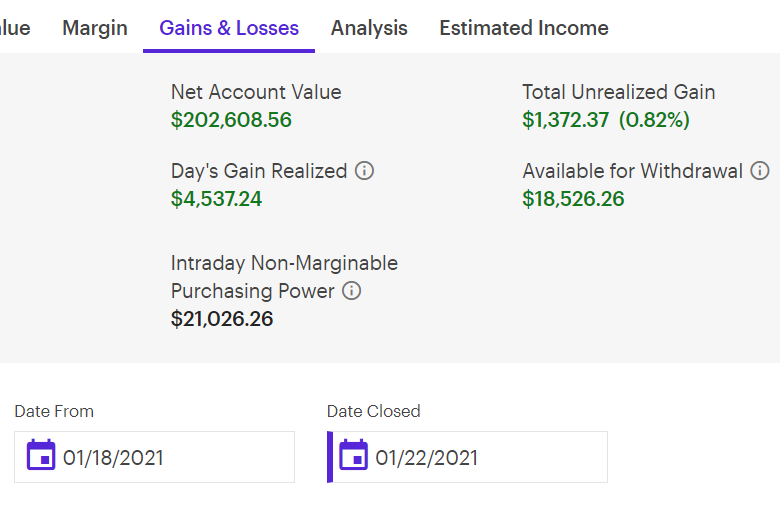Now that we got the clickbait title out of the way, let’s elaborate. Recently, I’ve been paper-trading an account to test a new options strategy called the wheel since the beginning of this week. The account was initially setup with $100,000 in cash and I managed to generate $1,274 this week alone. Assuming I can generate roughly $1,000 a week for the entire year, I could possibly make $52,000 or 52% return which singlehandedly beats the S&P 500 index. So what is this strategy? It’s called the wheel.
Strategy Explained
So what does the wheel strategy entail? Basically you start off with a cash position and you start writing / selling cash-covered puts if you don’t own the stock yet. You continue writing puts after each one expires similar to a waterfall effect. The goal is to not get assigned but even if you do, you can simply flip the strategy hence its naming.
In the event that you do get assigned, you do the opposite and start writing covered calls since you now own the stock. You continue writing calls similar to the put strategy mentioned above until you get assigned. If you do get assigned and have to sell your shares at the strike price, you repeat the process by writing cash-covered puts again.
This simple strategy done correctly can yield massive returns. Of course, that doesn’t mean that there are risks which we will cover later but take a look at potential returns.
Results

Take a look at the image above. For some context, this user started out with $76k last March in 2020 and generated $56k in gains. To date, that is roughly ~74% in returns beating the S&P500 and other similar benchmark indices.
The wheel is also called the triple income strategy because you’d be earning income not only from the premium received when you sell the option (both call and put), but also the gain in the underlying stock. If the stock pays a dividend while you own it, this would be the quadruple income strategy!
Risks
Of course, every investment has risks (if you find a strategy that is truly risk-free besides treasuries, please let me know!). The main risk with the wheel strategy is that it implies that volatility is high. If the volatility is low, then the options premiums won’t be high enough to justify utilizing the wheel strategy and you’d be better off buying options instead. Additionally, if the underlying stock tanks then you may be stuck writing call options with a very low premium. Here’s an example:
Let’s say you buy 100 shares of SPY which mimics the S&P500 index (1 option contract equals 100 shares of the underlying stock) at a cost basis of $377.36. We ideally want the underlying stock to go up and to lower our cost basis we start writing covered calls as part of our wheel strategy. So we sell a call at 390 strike price that expires on 2/1/21 (ideally we’d want to write options that are 30-60 DTE to collect a higher premium since theta works in our favor) and collect a premium of $0.74 or $74 since a contract is based on multiples of 100. Assuming that the stock price remains the same, we keep the premium as long as it never goes above $390 per share. Even if it does go above $390 and we get assigned, we still get to keep our premium of $74 and we collect a net profit of $12.64 per share or $1,264 total.
But what happens if SPY plummets? Let’s say on 2/1/21, the stock plummets to $300 a share and we have the worst recession since the Great Depression. You initial instinct may be to write calls slightly above the $300 market price as usual to collect a premium but if it gets assigned, you’d be locking in your loss! Additionally, if you write calls at your cost basis to break even you may get a smaller premium. This is where the wheel strategy backfires because we cannot sell the stock at such a depressed price since then we’d be turning our paper loss into an actual cash loss and the premiums we collect writing at our cost basis are very minuscule. The best we can do in this situation is to continue writing calls to lower our cost basis and hope to break even if it’s assigned. The wheel is not a market neutral strategy as it implies we have to be bullish on the underlying stock. Additionally, you should only perform the wheel strategy on a stock you wouldn’t mind owning in the long-term if a scenario aforementioned really happened.
Conclusion
The wheel is not a completely risk-free strategy but done correctly can make you a lot of money. Keep in mind that this strategy is not a get-rick-quick type of deal and requires patience and perseverance. Additionally, I don’t recommend doing this strategy on a broad index as simply buying and holding SPY would actually outperform the wheel strategy. Instead, pick a stock that you believe has long-term growth aspects and perform the strategy on that stock. Remember your limits and stick to covered options writing. Done correctly, this is a great way to build a “passive” income stream.
EDIT:
As of 1/29/2021, my paper trading portfolio has generated ~80% annualized returns using this strategy. It is currently too early to tell, but as of now I believe at minimum you would need $100,000 in order to replace a job with trading. I will keep you posted on this strategy and will provide monthly breakdowns of returns.

Pingback: Options Portfolio Update (Jan-21) - Crazy Finances